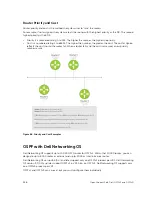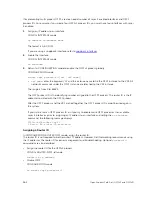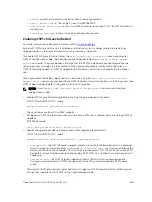
Loopback 0 is up, line protocol is up
Internet Address 10.168.253.2/32, Area 0.0.0.1
Process ID 1, Router ID 10.168.253.2, Network Type LOOPBACK, Cost: 1
Loopback interface is treated as a stub Host.
Dell#
Configuring Stub Areas
OSPF supports different types of LSAs to help reduce the amount of router processing within the areas.
Type 5 LSAs are not flooded into stub areas; the ABR advertises a default route into the stub area to which
it is attached. Stub area routers use the default route to reach external destinations.
To ensure connectivity in your OSPFv2 network, never configure the backbone area as a stub area.
To configure a stub area, use the following commands.
1.
Review all areas after they were configured to determine which areas are NOT receiving type 5 LSAs.
EXEC Privilege mode
show ip ospf process-id [vrf] database database-summary
2.
Enter CONFIGURATION mode.
EXEC Privilege mode
configure
3.
Enter ROUTER OSPF mode.
CONFIGURATION mode
router ospf
process-id
[vrf]
Process ID is the ID assigned when configuring OSPFv2 globally.
4.
Configure the area as a stub area.
CONFIG-ROUTER-OSPF-id mode
area
area-id
stub [no-summary]
Use the keywords
no-summary
to prevent transmission into the area of summary ASBR LSAs.
Area ID is the number or IP address assigned when creating the area.
Example of the
show ip ospf database database-summary
Command
To view which LSAs are transmitted, use the
show ip ospf database
process-id
database-
summary
command in EXEC Privilege mode.
Dell#show ip ospf 34 database database-summary
OSPF Router with ID (10.1.2.100) (Process ID 34)
Area ID Router Network S-Net S-ASBR Type-7 Subtotal
2.2.2.2 1 0 0 0 0 1
3.3.3.3 1 0 0 0 0 1
Dell#
To view information on areas, use the
show ip ospf
process-id
command in EXEC Privilege mode.
566
Open Shortest Path First (OSPFv2 and OSPFv3)
Summary of Contents for Z9000
Page 1: ...Dell Configuration Guide for the Z9000 System 9 7 0 0 ...
Page 80: ...grub reboot 80 Management ...
Page 128: ... 0 Te 1 1 Te 1 2 rx Flow N A N A 128 Access Control Lists ACLs ...
Page 491: ...Figure 70 Configuring OSPF and BGP for MSDP Multicast Source Discovery Protocol MSDP 491 ...
Page 496: ...Figure 73 MSDP Default Peer Scenario 1 496 Multicast Source Discovery Protocol MSDP ...
Page 497: ...Figure 74 MSDP Default Peer Scenario 2 Multicast Source Discovery Protocol MSDP 497 ...
Page 498: ...Figure 75 MSDP Default Peer Scenario 3 498 Multicast Source Discovery Protocol MSDP ...
Page 760: ...Figure 100 Single and Double Tag TPID Match 760 Service Provider Bridging ...
Page 761: ...Figure 101 Single and Double Tag First byte TPID Match Service Provider Bridging 761 ...
















































